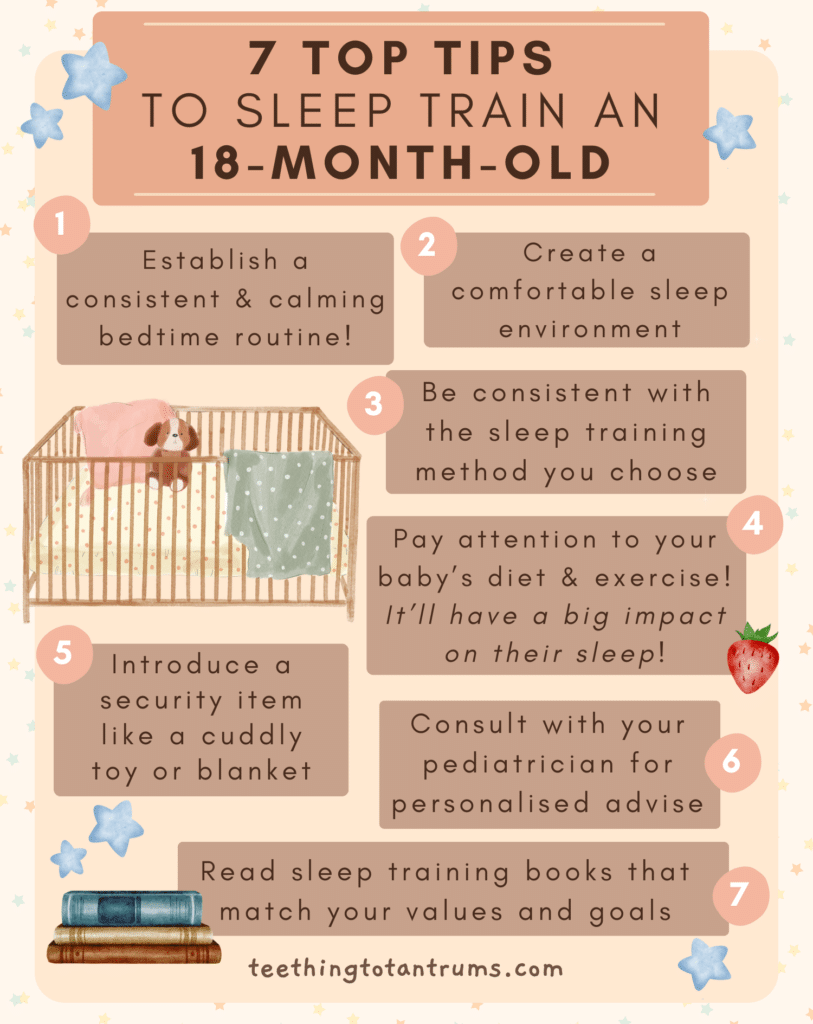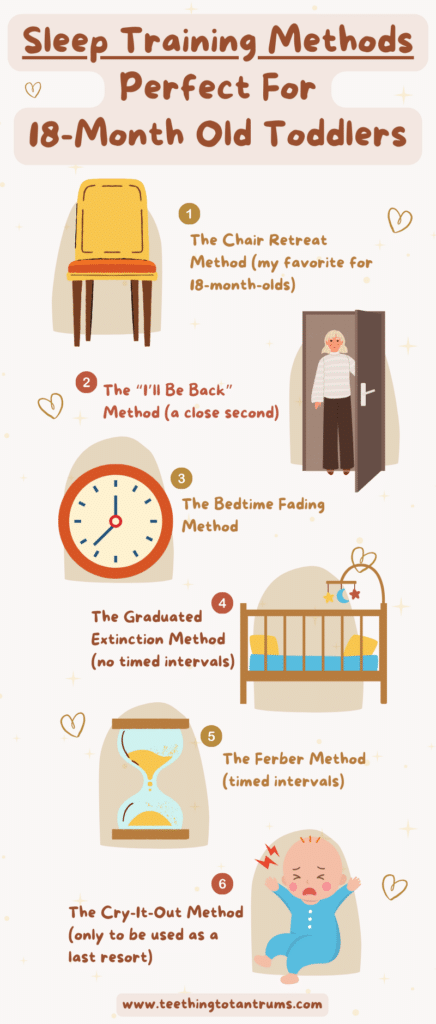Is bedtime a battleground in your home? Does your 18-month-old fight sleep with flailing limbs and piercing cries? Do you find yourself tiptoeing around after finally getting them down, praying they sleep through the night?
As a parent, lack of sleep can leave you drained. But it doesn’t have to be this way.
Inside this guide on sleep training an 18-month-old, you’ll discover proven techniques to transform bedtime from stressful to serene.
With step-by-step methods to encourage healthy sleep habits and teach your toddler to soothe themselves to sleep, you’ll all get the full night’s sleep you deserve in no time!

Table of Contents
Key Takeaways
- Establishing healthy sleep habits lays the foundation before formal sleep training methods. This includes a consistent bedtime routine, a proper sleep environment, and ensuring age-appropriate daytime sleep.
- Gentle sleep training techniques like the Chair Method and the “I’ll Be Back” Method are highly effective for sleep training an 18-month-old and avoid leaving them to cry it out.
- Being consistent with the sleep training method and prepared for common sleep training challenges like sleep regressions, night terrors, and transitioning from co-sleeping to independent sleep will ensure you have the highest chance of sleep success.
The Importance Of Sleep Training
As your toddler grows… various factors can disrupt their sleep schedule.
Whether it’s developmental changes, a parent returning to work, moving house, or starting daycare…
These disruptions can have a profound impact on your 18-month-old’s sleep.
And if their sleep habits were questionable before… then your toddler will certainly need some help to get their sleep back on track.
That’s where sleep training comes in.
Sleep training is a way of teaching your child to fall asleep and cope with waking at night and falling back to sleep without your presence.
In other words, it helps your little one to learn to soothe themselves and sleep through the night.
But why exactly is it important?
Firstly, consistent sleep patterns are essential for cognitive and physical growth. At 18 months, your child is gaining new skills like talking and walking. Quality sleep will support this rapid development.
Secondly, establishing good sleep habits early on can prevent long-term sleep issues. It sets a healthy foundation for your child’s future sleep into adulthood.
Remember, you’re not just teaching sleep; you’re teaching self-soothing skills.
Finally, it’s important for your well-being too. When your toddler sleeps better, so does the parent. With more rest, you’re able to be a more patient and attentive parent. This benefits your whole family’s overall happiness and health.
So how can you sleep train an 18-month-old quickly and effectively?
How To Sleep Train An 18-Month-Old Effectively
The first step on your sleep training journey is to ensure you have healthy sleep habits in place.
These tips should always be implemented BEFORE you start sleep training an 18-month-old, because you may find once they’re in place, you may not need to use a sleep training method.
You will also find that if you do decide to sleep train after implementing these healthy sleep habits, your chances of success will be far higher.

- Establish a bedtime routine. First and foremost (and this is something I am always emphasizing) creating a consistent bedtime routine is essential for your toddler. Start with calming activities an hour before bed that are screen-free. Follow this with a bath, a milky drink, and reading a book together. Offer acceptable choices so that your toddler feels they have some control over the routine too, such as choosing the bathtime toys, what PJs to where, or which 2 books to read.
- Ensure the environment in your toddler’s room promotes sleep. Consider using a nightlight or white noise machine to provide comfort and to help the room feel cozy. Soft sheets and comfortable sleepwear will also help your little one feel relaxed and snuggly.
- Be consistent. Consistency is key when it comes to sleep training an 18-month-old. Stick to the same routine at the same time every night and avoid making exceptions, even on weekends. It is also very important to keep bedtimes and naps on schedule and at the same times daily.
- Pay attention to diet and exercise: A balanced diet and regular exercise can help regulate your child’s circadian rhythm and melatonin production, making it easier for them to fall asleep at night. Avoid sugary or caffeinated foods and drinks in the evening and make sure they have plenty to eat during the day so that hunger is not the cause of nighttime waking. Toddlers aged between 4 months – 3 years old need around 82 kcal/kg/day.
- Introduce a security object. Toddler separation anxiety at night can be very overwhelming and having a favorite toy or blanket to provide comfort when your little one is learning to self-soothe can make all the difference.
- Consult with your pediatrician. I would also advise talking to your pediatrician if you have concerns about your toddler’s sleep habits. They can offer customized advice to tailor fit your particular family setup and allay any fears you might have about whether sleep training is the right course of action.
- Read some baby sleep training books. There are many sleep training methods to choose from and you must choose one that you feel comfortable with. A lot will depend on what sort of issues you are having and there is a lot you can do before embarking on conventional sleep training methods that may help your little one to successfully fall asleep alone and resettle themselves at night.
Remember, it might take some time for your toddler to adjust to these sleep habits, but the younger they are when they learn this essential skill the easier it is for the whole family.
Meaning the best time to start is today.
If, after you’ve implemented these techniques, you’re still struggling with nighttime wakings or getting your toddler to fall asleep peacefully… You should consider a more structured sleep training method.
Looking to get your little one to sleep quickly and effortlessly? Check out my Bedtime and Nap Cheat Sheet and master the art of making daytime naps and bedtimes as seamless as possible.
A bedtime & nap cheat sheet so good your little one will ask you to put them to bed...
Laura Williams "This is a life saver! I'm so glad I downloaded your bedtime & nap cheat sheet. My little one actually asked me to put him to bed last night! Unbelievable! Thank you so much!"
Click Here For The FREE Cheat Sheet
Suitable Sleep Training Methods For An 18-Month-Old
When considering sleep training for an 18-month-old toddler, several methods can help… However, as I have already said, it is about finding the right fit for your family.
You should never embark upon a sleep training method that does not feel right for you or your toddler or one that is causing unnecessary stress and anxiety.
So, with that in mind, after many years of being a Norland Nanny specializing in sleep issues and researching sleep training techniques, here are the top ways you can sleep train an 18-month-old toddler:

1. The Chair Method (My Favourite)
The Chair Method is one of my preferred methods for sleep training an 18-month-old and one that I have found to be very effective.
To implement this gradual and comforting method stay in the room with your little one after you have said goodnight, and sit next to their bed until they fall asleep.
Night after night, move the chair further away from the crib.
You should avoid talking to your toddler once the lights are out… But if they need comforting, (and you’re within reach) offer a tummy rub or kiss on the forehead, accompanied by a firm but kind “good night”.
2. The ‘I’ll Be Back’ Method (A Close Second)
Another one of my top sleep training methods for 18-month-olds is the ‘I’ll be back’ method.
To use this technique, start by settling your little one in their bed, saying “good night” and telling them that you need to attend to a chore.
Make sure the chore is very boring (laundry, emails, and cleaning are all good options), and reassure your toddler that you’ll return in a few moments.
Ensure that you do return as promised and repeat this process, gradually extend the time you are away doing whatever you have told them that you need to do.
(PS: you don’t have to go and do emails… it’s simply to stop your toddler from wanting to join in)
The crucial aspect of this sleep training method is that you return as promised.
Your returning will help build your toddler’s trust in you and over time you can gradually extend the time you are away and eventually they will be falling asleep alone before your first return.
3. The Bedtime Fading Method
If your child struggles to fall asleep, you may be tempted to push bedtime later.
However, this can easily backfire on you as it runs the risk of making your 18-month-old overtired… inhibiting their ability to self-settle and or stay asleep all night.
Instead, take a close look at daytime sleep to ensure they are not napping too late in the day. Toddlers need 3-4 hours of awake time before settling down to bed.
If your toddler is still struggling to settle to sleep at bedtime, consider pushing bedtime back by 10 minutes per night.
Always keep an eye out for your little one’s sleep cues and act on them to prevent overtiredness!
4. The Graduated Extinction
With the Graduated Extinction method, you let your little one cry or protest for progressively longer intervals before checking in on your toddler.
The idea behind this method is that your toddler will eventually get the message that they have to fall asleep without you.
This is not quite as harsh as the cry-it-out method as you do occasionally return to your toddler… but if all else has failed, the Graduated Extinction method might be a softer approach for you to try before going down the full cry-it-out route.
5. The Ferber Method
The Ferber Method is a well-known sleep training technique similar to graduated extinction but with a structured plan.
To implement the Ferber Method, once your 18-month-old has been put down to sleep, leave their room and only check in at set times to soothe your child, then leave again.
Gradually increase the intervals you leave your child for and eventually, your little one will fall asleep without your presence.
The Ferber Method can be very effective at getting children to learn to fall asleep independently… but it will involve a certain amount of crying and protesting from your little one.
If you do not want your toddler to cry or protest, try the Chair or I’ll Be Back methods first.
6. The Cry-It-Out Method (The Last Resort)
Also known as the full extinction method, the Cry-It-Out (CIO) method is a sleep training technique that is surrounded by a lot of controversy and one that I would only advise in very few extreme situations.
For this method you allow your child to cry until they fall asleep… without you ever re-entering the room.
It can be effective, but it’s tough to hear your little one cry for 10, 20, 30… even up to 60 minutes when falling asleep.
A Note On Cry It Out
I would always advise parents to approach the crying-out method with caution. Our job as parents and caregivers is to provide love, and comfort and make our children feel safe.
For me, the CIO method goes against those core principles and while I know how important it is for children to learn how to fall asleep independently, I feel that any sleep training has to be gentle and loving.
For your little one’s healthy development and for you to get the sleep you need, I believe that the sleep habits I identified earlier and the sleep training methods I have already mentioned can get the same results.
I have to admit that I have never used the CIO method as I have always managed to help young babies and toddlers fall asleep independently in a supportive, gentle, and loving way before requiring its use.
However, if you have tried all of my tactics and nothing has worked, the Cry-It-Out Method might be your last resort.
If this is the case, here’s more information about the Cry-It-Out method for you to consider: The Truth About The Cry-It-Out Method.
TOP TIP: Avoid sleep training if your little one is teething, unwell, or adapting to a new routine such as starting daycare. I would also not recommend sleep training and potty training at the same time. Your 18-month-old can only handle one change at a time.
Managing Naps When Sleep Training
When sleep training an 18-month-old, maintaining a consistent nap schedule is key. This is because daytime sleep has a huge impact on nighttime sleep.
Plan naps around the same time each day as this helps set your child’s internal clock for sleep and have a pre-nap routine that signals clearly to your little one that nap time is coming up.
First and foremost make sure your 18-month-old is getting the right amount of daytime sleep for their age to ensure they are neither overtired nor not tired enough when bedtime comes around.
To understand what the ideal sleep and nap schedule for an 18-month-old is, read this post: 18-Month-Old Sleep Schedule
QUICK REFERENCE: Many 18-month-old toddlers will still need 2 naps a day… If needed, aim for no more than 1 hour in the mid-morning and a nap of 1-2 hours taken after lunch. Your toddler should be getting around 2-3 hours of daytime sleep. Too little or too much will affect their nighttime sleep.
Sleep Training Books I Recommend
Having researched sleep training extensively and specializing in sleep issues as a Norland Nanny, here is a comprehensive list of what I consider to be the must-read toddler sleep training books on the market.
They are all ideal for sleep training an 18-month-old, so take a look and see which fits your sleep training requirements.
1. No-Cry Sleep Solution for Toddlers by Elizabeth Pantley and Harvey Karp
Unlike many sleep training books, the No Cry Sleep Solution is specifically designed to help parents who are battling with toddler sleep and offers a lot more than just sleep training an 18-year-old for bedtime.
Elizabeth Pantley tackles all manner of sleep issues such as naptime problems, special sleep issues for twins, repeated nighttime visits to parents’ beds and so much more.
If you are looking for a book that tries to look at toddler sleep issues from all angles then this is the one for you. You should also bear in mind that Elizabeth’s approach is gentle and child-centred so there will be no ‘crying it out’ in her solutions.
Gently guiding your toddler to better sleep becomes less of a battle with this book. The No-Cry Sleep Solution aims to provide you with researched, kind methods that respect your child's needs.
Implementing the tips provided feels relevant and doable, as each chapter follows through with advice matched to common situations.
What's truly beneficial is the understanding of sleep you gain. It's a relief to have your experiences validated and then addressed, flipping the script on bedtime struggles.
You're not just reading; you're learning and applying new strategies each night.
- Endorsed by many parents over the last 18 years for its effectiveness
- Focused on gentle techniques
- Includes valuable research insights
- Offers specific advice for 1-5 year olds
- Follows a gentle child-centred approach
- Covers a variety of bedtime issues such as night wakings and getting your toddler to stay in bed
- May not work for every child
- Some information might overlap with books you've previously read
- The solutions require patience and time
2. The Gentle Sleep Book by Sarah Ockwell-Smith
The Gentle Sleep Book covers a wide range of ages from 0-5 years but I have included it in my list as I know from personal experience many parents who have used it and found it invaluable and refer to it as their ‘Sleep Bible’.
I believe this book is ideal for parents who are more relaxed about toddler sleep training but still want to raise a child with healthy sleep habits.
Sarah Ockwell Smith provides a holistic insight into childhood sleep in this book. She explains that very often our expectations are way too high when we expect our little ones to sleep through the night and that we aim for this perfection when they are not developmentally programmed to do so.
In a lot of ways, this is a book that makes parents who are battling with sleep issues feel ‘OK’ with what they are doing whether that be co-sleeping or nursing to sleep.
If you are happy to take this more relaxed approach to sleep training then this is probably the book for you.
- Offers a gentle approach to sleep training
- Offers reliable evidence-based advice
- Deals with night wakings as well as bedtime issues
- Offers advice for each developmental stage
- Covers how to deal with daytime nap issues too
- Mentions that bed sharing is OK... which is not for everyone
- The solutions take time... however, there's never a quick fix
- May be considered more of a parent self-help book than a sleep training book
3. Solve Your Child’s Sleep Problems by Richard Ferber
The sleep training classic, Solve Your Child’s Sleep Problems, has been revised and updated to deal with bedtime battles, nighttime waking, sleep terrors, and bedwetting in our modern world.
Though the book is vast, it’s a well of wisdom and you will find it addresses situations many other books do not.
Patience is key when implementing the techniques laid out, but persistence transforms nights from waking nightmares into a peaceful slumber.
If you think Dr Ferber’s methods are about letting your little one cry it out, think again. This book has so much more to offer and can give you valuable insight into childhood sleep.
Where To Buy Sleep Training Books
There are endless places to buy sleep training books. Amazon is the first place most people think of when looking for books…
However, you can try looking for free books (or for a significantly reduced price) at garage sales, libraries, charity shops, and online second-hand book shops such as Awesome Books and Better World Books.
Your friends and family may even have a copy you can borrow, so ask around!
Addressing Common Sleep Training Challenges
When you start sleep training your 18-month-old, it is perfectly natural to encounter challenges and setbacks.
The trick is to know how to handle them:
- Teething and Illness: These can naturally disrupt sleep and do not require ‘sleep training” at all. The most important thing is to provide lots of love and comfort and consult your pediatrician if you have any concerns. Once better your little one has recovered you can then resume your preferred sleep training method.
- Separation Anxiety: It is very common for 18-month-olds to experience separation anxiety and this can quite naturally cause issues when it comes to separating from you at bedtime. Establish a soothing consistent bedtime routine, and offer a favorite soft toy or blanket for your little one to sleep with, white noise machines and audio apps are also great ways to offer comfort during this phase. Consider using a night light too. A more gentle sleep training method such as the Chair Method or I’ll Be Back is advisable if separation anxiety is the root cause of your little one’s bedtime issues.
- Sleep Regression: Sleep regressions can occur at any age for a large variety of reasons and they can certainly lead to your toddler struggling to fall asleep independently and deal with nighttime waking. You must stay consistent with bedtime practices and offer lots of love and assurance to your child during this transition. To learn more about how to handle the 18 month sleep regression, read this post: The 18 Month Sleep Regression Survival Guide
- Night Terrors and Nightmares: Another common sleep issue at this age is night waking due to toddler nightmares and terrors. Use the checklist listed in the separation anxiety point to ensure that your little one is feeling safe and secure. Make sure you know the difference between nightmares and night terrors as they need to be handled differently: Toddler Nightmares: 6 Tricks To Prevent Them From Happening and Night Terrors In Toddlers: Don’t Panic! Do These 7 Things.
- Night Wakings: If your little one is waking at night and struggling to re-settle, always check to make sure your toddler is not unwell or in any discomfort, and then re-settle them with your chosen sleep training method. Keep conversation to a minimum and interaction very low-key. Try to offer comfort without picking them up if possible. TOP TIP: When your 18 month old wakes at night resist rushing in straight away as sometimes they may resettle on their own.
- Daytime Sleep: This is very important as adequate age-appropriate naps will reduce the chances of overtiredness. An overtired toddler will most definitely struggle to fall asleep and stay asleep so getting daytime sleep right can be a game changer and improve nighttime sleep significantly.
- Night Weaning: If you are night weaning your 18-month-old you will likely go through a transition phase with your little one waking to be fed on some nights, but not others. To help with nighttime fed weaning, gradually reduce night feedings by offering water instead of milk and replace feeds with comforting patting or a soft word to promote independent sleep. Ensure your little one is getting enough to eat in the lead-up to bedtime to ensure your toddler is not waking from hunger. REMEMBER: 18-month-olds do not need to be fed at night for nutritional purposes and you are just teaching them to break a comforting habit they have become used to.
- Co-Sleeping to Independent Sleep: If you have been co-sleeping then making the transition to their own bed can be hard for toddlers. Make the transition slowly. Start with naptimes in their own space before moving to bedtime and subsequently full nights. You could also start by putting your little one’s crib or bed in your room first and then move them to their own room in a week.
Whilst this all sounds like a lot… remember that setbacks are normal and can occur at any time.
If your child is struggling with sleep, take a step back and reassess your sleep training methods. You may need to take a break from sleep training for a short while or you may need to try a different method.
When To See A Pediatrician
Your pediatrician will be able to rule out any underlying conditions that may be affecting your little one’s ability to sleep well or allay your fears and allow you to continue the sleep training process without concern.
Signs you should talk to your pediatrician about your 18-month-old’s sleep include:
- Your child snores loudly or has breathing pauses.
- Frequent night wakings occur every night despite implementing healthy sleep habits.
- Changes in daytime behavior or mood signal persistent overtiredness.
- Frequent nightmares or night terrors
- Unusual sleep movements or behaviors (both at night or in the evening)
- Changes to your child’s normal eating habits.
In some cases, your pediatrician may refer you to a pediatric sleep consultant as they’re equipped to handle complex sleep issues.
It is a good idea to go to your appointment well-prepared. Make a note of sleep patterns in a diary and any concerns and observations you have.
This helps your pediatrician better understand the issues and have a clearer picture of what is going on at bedtime and nap time.
With one spacious page dedicated to each day, you'll have plenty of room in this delightful planner to write down all your to-dos, appointments, and notes for the year.
Ideal for parents tracking baby's sleep, feeding, and pooping schedules...
Or a sleep journal for toddlers...
Whatever your requirements for the diary need to be, this handy planner will tick the right boxes.
Frequently Asked Questions About Sleep Training An 18-Month-Old
Navigating sleep training for your 18-month-old can raise many questions. This section addresses your concerns with clear guidance.
Q: How much sleep do 18-month-olds need?
A: Your average 18-month-old will need between 11 and 14 hours of sleep in a 24-hour period. This will consist of 10-12 hours taken at night and the rest taken over 1 to 2 daytime naps.
Q: What is the recommended duration for the ‘cry it out’ method with an 18-month-old?
A: The Cry It Out method does not have a set crying duration. You simply leave your baby to cry until they fall asleep by themselves. This can take anywhere from 10-60 minutes.
Q: What is the 5-10-15 method?
A: The 5-10-15 method is a version of graduated extinction and involves checking and comforting your child at set intervals of 5, 10, and 15 minutes. This will gradually increase your toddler’s self-soothing ability.
Q: How can I encourage my 18-month-old to sleep through the night?
A: To help your 18-month-old sleep through the night, establish a consistent bedtime routine and ensure the sleep environment is conducive to uninterrupted sleep. Also, ensure they are getting enough daytime sleep as overtiredness will impact your little one’s ability to stay asleep all night.
Q: How can I help my 18-month-old learn to sleep independently?
A: To help your toddler sleep independently, use consistent routines and clear sleep cues. Provide them with comfort from white noise machines, audio apps, and a comfort blanket or toy.
Need More Parenting Help?
- Download our FREE Bedtime & Nap Sleep Cheat Sheet. It’s a free, easy-to-use and proven formula designed for parents of 0-5 year olds to master the art of consistently undisturbed and restful sleep without the yelling, nagging or exhausting long-winded evenings.
- Check out our Parenting Toolbox. You’ll get access to expertly-chosen products that you can guarantee are the best for your little one and your wallet.
- Are you looking for personalized guidance to navigate the challenges of parenting? I offer 1-on-1 consultations to bring you tailored strategies and actionable advice to help support your child's growth and well-being with confidence.

A bedtime & nap cheat sheet so good your little one will ask you to put them to bed...
Laura Williams "This is a life saver! I'm so glad I downloaded your bedtime & nap cheat sheet. My little one actually asked me to put him to bed last night! Unbelievable! Thank you so much!"
Click Here For The FREE Cheat Sheet






